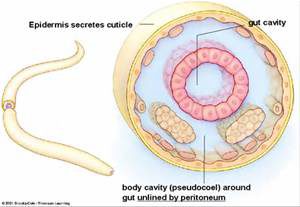One way to develop new height growth techniques would be to study how the hydrostatic skeleton works and since hydrostatic pressure is a key way that hydrostatic skeletons stay structurally sound. We can use the methods that hydrostatic organisms generate hydrostatic pressure and use those methods on our endoskeletons.
“A hydrostatic skeleton or hydroskeleton is a structure found in many soft-bodied animals consisting of a fluid-filled cavity, the coelom, surrounded by muscles.”
Here’s an image:
Another description: ”
A hydrostatic skeleton is one formed by a fluid-filled compartment within the body: the coelom. The organs of the coelom are supported by the aqueous fluid, which also resists external compression. This compartment is under hydrostatic pressure because of the fluid and supports the other organs of the organism. This type of skeletal system is found in soft-bodied animals such as sea anemones, earthworms, Cnidaria, and other invertebrates .”
“earthworms move by waves of muscular contractions (peristalsis) of the skeletal muscle of the body wall hydrostatic skeleton, which alternately shorten and lengthen the body”<-earthworms grow shorter and taller almost at will.
Another description:
“A hydrostatic skeleton is a structure found in many cold-blooded and soft-bodied organisms. It consists of a fluid-filled cavity, which is surrounded by muscles. The cavity is called a coelom and in some animals this cavity is filled with a blood-like substance called haemocoel. The fluid presses against the muscles, which in turn contract against the pressure of the fluid. The fluid is incompressible and thus maintains a constant volume against which the muscles can contract.”
Maybe high hydrostatic pressure in bone serves as a temporary hydroskeleton which allows for temporary loss of osteo-structural components and allow for things such as the growth plate. Maybe we need to stop think of it is an osteochodral skeleton but a hydroosteochondral skeleton where the hydroskeleton allows the skeleton to function without all the osteocomponents.
ONTOGENETIC SCALING OF HYDROSTATIC SKELETONS: GEOMETRIC, STATIC STRESS AND DYNAMIC STRESS SCALING OF THE EARTHWORM LUMBRICUS
TERRESTRIS
“Hydrostats are constructed of an extensible body wall in tension surrounding a fluid or
deformable tissue under compression. It is the pressurized internal fluid (rather than the rigid levers of vertebrates and arthropods) that enables the maintenance of posture,
antagonism of muscles and transfer of muscle forces to the environment”
“The major source of static load on the body wall of a hydrostatic skeleton is internal pressure (P). Pressure can be generated by the contraction of muscles in the body wall surrounding the incompressible fluid and/or by mechanisms such as ciliary pumps (e.g. in sea anemones), osmotic pressure (e.g. notochords) and gravitational pressure (the gradient of pressure
produced in a static fluid by its own weight”
“hydrostats tend to be highly deformable”
“The main source of loading on the skeleton of most terrestrial organisms with rigid skeletons is body weight. In earthworms, the main source of loading on the skeleton is internal pressure (generated by body wall muscles contracting against a constant volume of internal fluid)”
“The upper limit to the size of hydrostatic skeletons is unclear, but some of the possible limitations to giant earthworms include (1) a decreased respiratory surface area
due to the low surface-to-volume ratio compared with that of smaller earthworms, (2) an increased importance of gravitational pressure as a source of load on the body wall, (3)
an increased frictional resistance to burrowing, and (4) the exponential increase in the cost of tunnel construction with increasing body diameter”<-An upper limit to hydrostatic skeletons would not be good as it would imply limitations on generation hydrostatic pressure but none of these reasons would seem to impede a structural limitation on hydrostatic skeleton size.
Scaling of the hydrostatic skeleton in the earthworm Lumbricus terrestris.
“We used glycol methacrylate histology and microscopy to examine the scaling of mechanically important morphological features of the earthworm Lumbricus terrestris over an ontogenetic size range from 0.03 to 12.89 g. We found that L. terrestris becomes disproportionately longer and thinner as it grows. This increase in the length to diameter ratio with size means that, when normalized for mass, adult worms gain ~117% mechanical advantage during radial expansion, compared with hatchling worms. We also found that the cross-sectional area of the longitudinal musculature scales as body mass to the ~0.6 power across segments, which is significantly lower than the 0.66 power predicted by isometry. The cross-sectional area of the circular musculature, however, scales as body mass to the ~0.8 power across segments, which is significantly higher than predicted by isometry. By modeling the interaction of muscle cross-sectional area and mechanical advantage, we calculate that the force output generated during both circular and longitudinal muscle contraction scales near isometry.”

